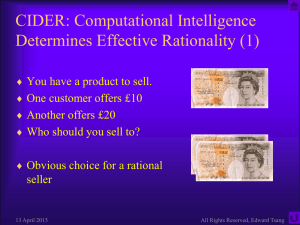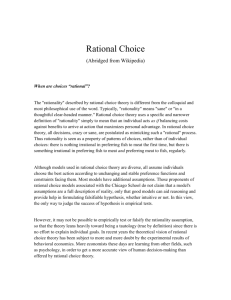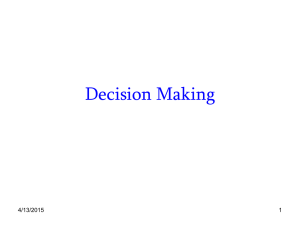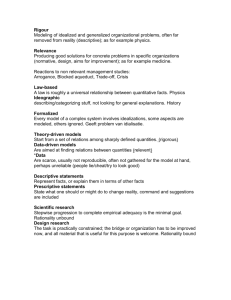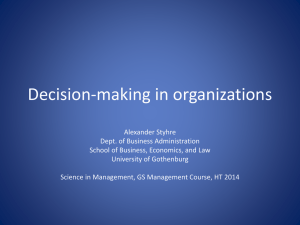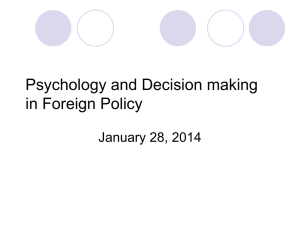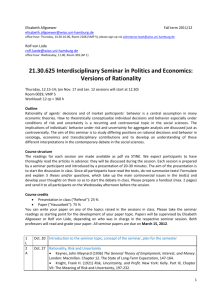Bounded Rationality and Transportation Behavior – Lessons
advertisement
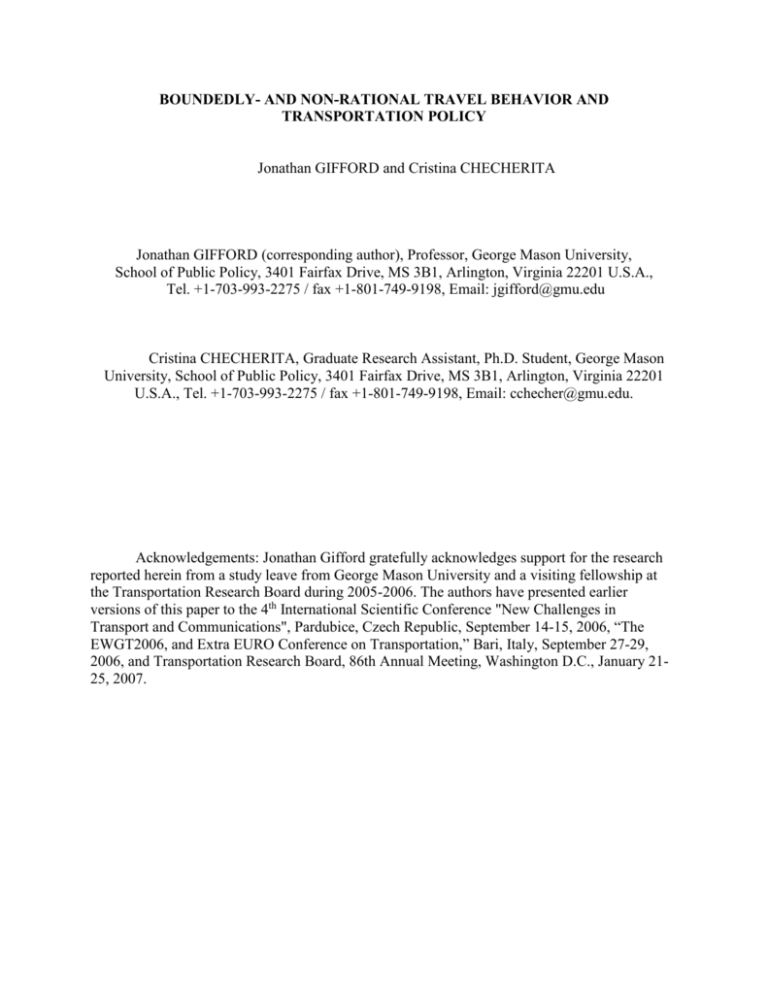
BOUNDEDLY- AND NON-RATIONAL TRAVEL BEHAVIOR AND TRANSPORTATION POLICY Jonathan GIFFORD and Cristina CHECHERITA Jonathan GIFFORD (corresponding author), Professor, George Mason University, School of Public Policy, 3401 Fairfax Drive, MS 3B1, Arlington, Virginia 22201 U.S.A., Tel. +1-703-993-2275 / fax +1-801-749-9198, Email: jgifford@gmu.edu Cristina CHECHERITA, Graduate Research Assistant, Ph.D. Student, George Mason University, School of Public Policy, 3401 Fairfax Drive, MS 3B1, Arlington, Virginia 22201 U.S.A., Tel. +1-703-993-2275 / fax +1-801-749-9198, Email: cchecher@gmu.edu. Acknowledgements: Jonathan Gifford gratefully acknowledges support for the research reported herein from a study leave from George Mason University and a visiting fellowship at the Transportation Research Board during 2005-2006. The authors have presented earlier versions of this paper to the 4th International Scientific Conference "New Challenges in Transport and Communications", Pardubice, Czech Republic, September 14-15, 2006, “The EWGT2006, and Extra EURO Conference on Transportation,” Bari, Italy, September 27-29, 2006, and Transportation Research Board, 86th Annual Meeting, Washington D.C., January 2125, 2007. 2 Abstract: This paper examines bounded rationality and non-rational travel behavior and their implications for transportation policy. Its primary aim is to assess how well policy and planning models address such behavior and whether such behavior matters in a public policy sense. The paper concludes that it is necessary to incorporate bounded rationality more extensively in travel demand modeling, especially at small-scale levels. This could help understanding patterns that do not usually correspond to the utility maximization paradigm. 3 INTRODUCTION Transportation choices are deeply rooted in the habits and sentiments of travel decision makers. Moreover, travelers do not devote all available attention to making their travel choices on the basis of the most recent information every morning before setting off on their commutes. The most accurate predictor of a commute trip today is the commute trip yesterday. Habit and routine matter. Yet, efforts by transportation planners over the last half century have focused primarily on predicting travel on the basis of rational factors. The choice of which shopping center to visit, or which grocery store, or which house of worship, derive in part from rational and objective criteria about travel time, travel reliability and distance. But non-rational factors play an undeniably significant role. The embodiment of such rational modeling is discrete choice modeling based on random utility maximization (RUM), parameterized and applied to transportation demand by Daniel McFadden in the early 1970s, work for which in part he later won the Nobel Prize in Economics. Yet scholars as early as Mahmassani and Chang (1987) recognized that cognitive limitations on attention and computational capacity constrain optimization behavior. Recent departures from the RUM framework for transportation planning have begun to emerge through rule-based models such as those developed by Arentze and Timmermans, and Bhatt et al. Yet does it matter from a public policy sense if behavior is better explained by the RUM framework or bounded rationality? Would policy decisions be any different if models reflected the boundedly rational and emotional factors that influence travel behavior? How well is attention scarcity addressed in policy and planning models? Do calls for broader application of congestion pricing and avoidance of “wasteful commuting” presume the devotion of an 4 unreasonable or undesirable amount of attention to transportation choices at the expense of other worthy subjects? This paper examines the question of the policy relevance and significance of boundedly rational and emotional behavior for transportation policy makers. It begins with a brief discussion of the concept of bounded rationality and “affective” (or emotional) factors, including their treatment in the social sciences. It next discusses how the transportation literature has addressed these questions. The paper then turns to the available public policy approaches to dealing with bounded rationality and affective behavior. A final section discusses policy findings and recommendations. BOUNDED RATIONALITY IN THE COGNITION-AFFECT SPECTRUM A rational process of choice, in a stricter (or looser) form, implies consideration of all (or as many as possible) alternatives, in a panoramic fashion; evaluation of their consequences; and selection of the alternative that maximizes a preferred value criterion, usually utility. In addition, the economic theory of rational choice is based on the fundamental assumption of consumer sovereignty – that consumer preferences are innate, pre-determined in any choice situation and independent of the alternatives available for choice. “Bounded rationality” seems to come closer to the way most choices are made in real life. It refers to the cognitive limitations facing a human decision maker due to the finite amount of attention and knowledge available for consideration of all existing alternatives and their consequences in solving a particular problem. The term was introduced by Herbert Simon in the 1950s. In his first edition of Administrative Behavior, published in 1948, Simon classified an individual’s limits or boundaries to rationality into three categories: (i) the individual’s 5 unconscious skills, habits and reflexes; (ii) his values and conception of purpose; and (iii) the extent of his knowledge and information (Simon, 1948). Theories of bounded rationality are defined as those that “incorporate constraints on the information capacities of the actor” (Simon, 1972). In the third edition of Administrative Behavior (1976), drawing on previous works, Simon altered two assumptions to transmute the utility-maximizing “economic man” into a man of bounded rationality, “the administrative man,” recognizable from everyday life: (i) The boundedly-rational man “satisfices,” that is, looks for a course of action that is satisfactory or “good enough” and not necessarily optimal. The Scottish word “satisficing” was revived by Simon in 1957 to “denote problem solving or decision-making that sets an aspiration level, searches until a satisfactory alternative according to this aspiration level is found and selects that alternative” (Simon, 1972). This process is different from utility maximization as it entails a sequential analysis of alternatives, that is, the comparison of one alternative at a time with a given benchmark instead of trading-off all alternatives simultaneously. Hence, a choice can be made without analyzing all possible (or all known) alternatives. The choice process with bounded rationality is not necessarily static, as the aspiration level may change in the sequence of trials. If individuals find it easy to discover satisfactory alternatives, their aspiration level rises; if they find it difficult, the aspiration level falls (Simon, 1955). (ii) The boundedly-rational man drastically simplifies the model of the world, that is, individuals ignore those aspects of reality that appear irrelevant at a given time. This means that decisions can be made with relatively simple rules of thumb that allow people to economize on their cognitive capacities or “not to make impossible demands upon people’s capacity for thought” (Simon, 1976). 6 This simplification is a result of “the limitations upon the capacities and complexities of the organism,” as well as of “the fact that environments to which it must adapt possess properties that permit further simplification of its choice mechanisms” (Simon, 1956). Environment adaptation is the general view of psychologists on behavior and theory of choice. In this view, the behavior is highly adaptable and context-dependent. People are influenced by other people’s actions; they may rely on principles/rules and analogies to make a choice; the way a problem is presented may affect the decision-making process (framing); people may simply travel to a certain destination because it is “fashionable” to go there; some may take a different route if an information stimulus, such as advertising of the benefits in terms of reduced congestion, catches their attention. Another departure from full-blown rationality is non-rational behavior. While bounded rationality implies a reasoning process in finding satisfactory alternatives, non-rational behavior is defined by psychologists “as an impulsive response to affective mechanisms without an adequate intervention of thought” (Simon, 1982). There is a complex relationship in psychology between affect and cognition, with many, if not all, cognitive beliefs influenced by affect or emotions, and conversely. In this gray area between cognition and affect, it is often hard to know where “cognitive” stops and “affective” starts. Non-rational behavior incorporates the extreme end of this continuum - those affective factors that do not involve a deliberate process of cognition when a choice is made1. Social science has long accepted that human agents are subject to “bounded rationality.” Apart from the field of psychology, where the concepts are extensively studied, boundedlyrational and non-rational behavior have been incorporated in various domains of social science, including organizational theory and the theory of public policy, finance and economics, and 1 The authors thank an anonymous reviewer for the useful insights provided on this issue. 7 software design. The behavioral finance has made great advances in this respect and many findings of this literature can be extrapolated to other fields, including transportation. Of particular interest is the idea of limited attention and the role of “glittering” news in catching individuals’ attention (Barber and Odean, 2005) (Huberman and Regev, 2001). One of the most influential papers in behavioral economics is Kahneman and Tversky (1979), a critique of expected utility theory developing an alternative model, called “prospect theory.” Choices among risky prospects exhibit several pervasive effects that are inconsistent with the basics of utility theory. In particular, people underweight outcomes that are merely probable in comparison with outcomes that are obtained with certainty, although they yield the same expected utility (the so-called certainty effect). In addition, in order to simplify the choice between alternatives, people generally discard components that are shared by all prospects under consideration and focus only on components that distinguish them. This phenomenon, called the isolation effect, leads to inconsistent preferences when the same choice is presented in different forms. BOUNDEDLY AND NON-RATIONAL CHOICE IN TRANSPORTATION LITERATURE In the transportation field, relatively recent studies find that individuals are using heuristics in circumstances like habitual traveling, short-distance traveling for shopping purposes (submetropolitan) or, even in general, in activity-based transportation. Affective rules embedded in the “endowment effect” (emotional attachment to one’s property), desires and affinities (travel for the sake of traveling), and social motives (social comparison, self-presentation, norms) may contribute to so-called “wasteful” driving and “wasteful” commuting. 8 As early as 1987, Mahmassani and Chang proposed modeling transportation patterns, such as departure time, using “boundedly-rational user equilibrium (BRUE).” According to their model, BRUE can be attained when all users are satisfied with their travel choices (i.e., do not necessarily optimize), meaning that they set an indifference band of tolerable negative outcome (for instance schedule delay) and can make the same travel choice as long as the previous outcome has been within the indifference band. The band reflects travelers’ aspiration level, which can change in the process of learning and interaction with the environment. This means that when BRUE exists, it may not be unique – as the equilibrium point in most optimization processes – which would pose dilemmas for flow prediction (Mahmassani and Chang, 1987). From a public policy standpoint, the question is whether to base policy on dynamic modeling with a unique solution, but not real empirical validation, or on models that incorporate more realistic assumptions, but may not be as stable and may not provide a definite solution. Tversky and Kahneman’s prospect theory has been applied in a travel choice context in works by (Avineri and Prashker, 2004), (Senbil and Kitamura, 2004), (Katsikopoulos et al., 2002), (Bogers et al., 2006) and others. In a route-choice stated-preference experiment, Avineri and Prashker found evidence of two violations of the expected utility theory: the certainty effect (underweighting of high probabilities in favor of certain travel time outcomes) and inflation of small probabilities. The authors concluded that the higher the variance of travel time, the lower the traveler’s sensitivity to travel time differences. In some cases, increasing travel time variability of a less attractive route was found to increase its perceived attractiveness. Bogers, Viti et al. summarize the literature’s findings on the value of route choice unreliability and conclude that it is in most cases found to be negative. The positive valuation of a route unreliability found in some cases is 9 explained by the subjective perception of probabilities and outcomes relative to a reference point (and not the absolute values), as theorized by Tversky and Kahneman. In their own experiment, Bogers, Viti et al. (2006) find that expected travel variability is negatively valued, as are expected travel time and the worst experience. Analyzing route switching behavior after a regular experience, as well as after an extreme experience, the authors find that people switched routes after an extreme experience significantly more often when the information they received before the route choice was wrong than when it was correct. They also found that travelers preferred a route which is sometimes very bad and most of the times good over a route which is symmetrically distributed. As emphasized by the authors, this relatively new field of travel simulations and experiments is still subject to further improvement. Habitual travel is seen by many authors as an example of boundedly-rational behavior. The issue of habitual travel and the possibility of inducing change is not fully clarified: some researchers find that travel behavior is neither totally repetitious nor totally variable (Schlich and Axhausen, 2003), some find that habits can be broken (Fujii and Kitamura, 2003), and others find habits more difficult to break (Garvill et al., 2003). Garling and Axhausen provide a comprehensive notional framework for habitual travel choice. They emphasize that the role of habit in travel behavior is important for transportation demand management because a choice that is non-deliberate may in fact be difficult to influence with rational arguments (e.g., increased costs), since the person making the choice tends to discount relevant information. However, it is important to define habitual travel properly. If habit is defined as the repeated performance of behavior sequences, then it may be the result of the fact that the cost of searching for and constructing new alternatives is generally too high and the expected gains associated with new alternatives too uncertain. Hence, the authors stress that 10 other methods must be developed to classify behavior, such as deliberative versus script-based choice (information stored in the memory in the form of a script is retrieved, alleviating the participants from deliberative information processing when making the choice). Another classification can be made based on the degree of deliberation. Inducing increased awareness and offering incentives may be ways of breaking “bad” travel habits (Garling and Axhausen, 2003). Schlich and Axhausen use long-duration longitudinal data to test intrapersonal variability in travel behavior. The data set is the result of a six-week travel diary, involving 361 persons. The paper finds that travel behavior is neither totally repetitious nor totally variable (Schlich and Axhausen, 2003). Fujii and Kitamura found that a temporary structural change (a free bus ticket offered for a month) could induce a lasting increase in drivers’ public transportation use. The study surveyed both changes in attitudes and actual behavior. The results of the study showed that attitudes towards bus travel after the experiment were more favorable and that frequency of the bus use increased, whereas the habits of using automobiles decreased, even one month after the intervention period. The results suggest that a temporary structural change might be a useful tool in travel demand management. However, as recognized by the authors, the sample size was small and the period between the first and last phase of the experiment (1 month) was too short to draw conclusions on a “lasting effect” (Fujii and Kitamura, 2003). Garvill, Marell, and Nordlund deal with deliberate attitudes versus habitual behavior and investigate if and how increasing awareness of choice of travel mode could affect the relations between attitudes to car use, car-use habits and actual car use. Attitude, habit, and behavior were measured in travel diaries and questionnaires. Contrary to what was expected, the experiment of increasing awareness of travel mode choice resulted in no significant strengthening of the 11 correlation between attitude and behavior and no significant decrease in the relationship between habit and behavior as regards car use. It resulted, however, in a temporally extended decrease in car use in the experimental group, subject to higher travel choice awareness. Still, as noted by the authors, these choices might have been influenced by specific contextual factors, which could explain why the correlation between car attitude and car use did not increase. Another explanation was that deliberate and habitual choice were reflections of different parallel processes, controlled versus automatic, and that the induction of a deliberate choice process would not influence habitual choice (Garvill et al., 2003). Many authors (e.g., Cao and Mokhtarian (Cao and Mokhtarian, 2005), Handy, Weston et. al. (Handy et al., 2005), and Steg (Steg, 2004)) emphasize the role of affective factors in travel decisions and the difficulty of quantifying and incorporating such factors in travel demand management. Such studies find that choice of travel-related strategies is affected not only by instrumental factors (e.g., amount of travel, safety, speed, cost), but also by attitudes (cognitive, affective and behavioral), as well as social motives (emotions like pleasure, arousal or stress; self-expression of social position, etc.). The findings imply in many cases that policies designed to alleviate congestion may be less effective than expected, because these qualitative factors are seldom measured and incorporated into demand models. There has been, nevertheless, a sustained effort in the transportation literature to measure attitudes (especially cognitive and affective and less so behavioral) and incorporate them into demand modeling. As reviewed in Parkany et al. (2004), attitudinal data is generally collected through a paper survey, containing questions related to the intent to use a new transportation alternative (with answers ranging from no, moderate, or heavy intent); approval ratings for new alternatives and perception variables; environmental desires and attitudes; need for timesaving 12 and flexibility, sensitivities to costs and stress; public transport use and perceptions. Methodologies used in transportation studies to analyze attitudinal data vary from simple statistical tests, showing whether differences in choices based on different attitudes are statistically significant, to more-complicated multistage models developing latent variables from attitudinal variables and then using structural equations or a hybrid choice procedure to model traveler choices (Parkany et al., 2004). Short distance travel is usually hypothesized to be more extensively subject to lack of proper planning, affective rules (mood, emotions) or habit. Personal vehicle use in the United States is overwhelmingly local, whether measured in terms of trips or travel (almost 90 percent of personal vehicle trips are less than 20 miles, comprising 55 percent of all personal vehicle travel) (Gifford, 2003)). Walking especially could be more prone to emotions. Indeed, American architect David Rockwell thinks that people’s movement can be “choreographed” by the design of the building or the public space in which they walk, and his ideas are being utilized in the design of airport terminals (Green, 2006). In a study of shopping travel behavior, based on a simple statistical analysis, Burnett identifies situations where utility maximizing rules are supplemented by simple heuristics and advocates for a shift beyond rational choice and metropolitan scale analysis (Burnett, 2006). Passini, Golledge, Bovy and Stern, and others have studied the psychological factors related to wayfinding (mainly to destination choice and path selection) in a travel behavior context. Passini considers that behavioral actions are linked to the original task over a set of intermediary decisions and subtasks. The original complex task of wayfinding is broken down into subtasks, more manageable, which are undertaken sequentially, in semi-isolation, while still taking into account the problem as a whole. With respect to the dynamics of decision-making, 13 Passini holds that it would be erroneous to assume that for an unfamiliar task, a person could work out a total plan and then execute it. Instead, the wayfinding protocol assumes that people have only a global and vague plan consisting merely of a few general ideas, and that they gradually incorporate new information and deal with unforeseen problems as they occur (Passini, 1992). Golledge contends that, traditionally, the path selection problem has been ignored or assumed to be the result of minimizing procedures such as selecting the shortest, quickest, or least costly path. He develops experiments with route selection to determine relevant criteria when environment changes and the number of nodes along a path are increased, such as in trip chaining (Golledge, 1995). PUBLIC POLICY APPROACHES TO BOUNDEDLY AND NON-RATIONAL CHOICE IN TRANSPORTATION The investigation of the ways bounded rationality is treated in the transportation literature suggests three public policy approaches: (i) ignore or marginally treat the “problem”; (ii) remedy the “problem”; or (iii) accept bounded rationality as a norm. (i) Ignore the Problem or Treat It Marginally This approach assumes that rational behavior is the norm in people’s choice processes and that individuals can meet the logical requirements and search continuously for optimal solutions. Individuals do optimize their utility, subject to their budget and time constraints or, equivalently, given the associated transaction costs. People may limit their choice to only two or three 14 alternatives, but this is a rational process, given that they estimate the transaction costs of further analysis as too high and the benefits as too uncertain. Since 1970, when McFadden and Domenich estimated a disaggregated urban travel demand using McFadden’s discrete choice model parameterized as conditional logit, the development of discrete choice models has been framed within the random utility maximization (RUM) framework (McFadden, 2001). RUM assumes that individuals act as rational decision makers, optimizing their direct and indirect utility, with randomness in utility coming from heterogeneity in preferences, due to both inter- and intra-personal variation. Alternatively, this approach often acknowledges bounded rationality and non-rational behavior, but ignores them in modeling due to difficulties and potential distortions that would result from incorporating highly qualitative variables (yet at the expense of reflecting more realistic assumptions). (ii) Remedy the Problem This approach acknowledges bounded rationality and non-rational behavior, while treating rational behavior and optimization as the normative standard. Hence, it suggests that policymakers should identify interventions that improve the efficiency of individuals’ choice processes and their long-term interests. Examples of such strategies include increasing awareness of travel mode choices and real-time information about traffic. Such interventions must be demonstrably superior to the status quo, and in that sense meet Williamson’s “remediableness” criterion, which holds that “An extant mode of organization for which no superior feasible alternative can be described and implemented with expected net gains is presumed to be efficient. To be sure, public policy analysis becomes more 15 complicated when analysts can no longer condemn extant modes because they deviate from a hypothetical ideal” (Williamson, 2000). This approach would also broadly correspond to the recently revived notion of state paternalism, this time as “soft” or “libertarian” paternalism as opposed to either “hard paternalism” or the “nanny state.” Thaler, Sunstein, Beshears, Laibson, Choi and Madrian are among the principal supporters of state soft intervention for “behavioral” reasons. They argue for guidance, or even acting on behalf of individuals, for example in matters of default retirement plan options, but leaving the final choice to the individual (2006). (iii) Accept Bounded Rationality as a Norm and Incorporate It into Modeling. This approach accepts that using heuristics is the norm of choice behavior and may not be suboptimal. Gigerenzer and Goldstein (1996) find that satisficing rules can match or even outperform various rational inference procedures. They argue that classical rationality should not be necessarily considered as a normative standard and warn against the confusion of equating bounded rationality with biases. Drawing from Simon’s principles, the authors propose and test “satisficing algorithms that (i) operate with simple psychological principles that satisfy the constraints of limited time, knowledge, and computational might, rather than those of classical rationality; [and] (ii) are designed, at the same time, to be fast and frugal without a significant loss of inferential accuracy, because the algorithms can exploit the structure of environments” (Gigerenzer and Goldstein, 1996). The authors test only two alternative-choices on a quantitative dimension, based on inferences from memory, not from givens. Their examples refer to “inferences that need to be made with limited time and knowledge” and can be extended, inter alia, to “decision-making and 16 risk assessment during driving (e.g., exit the highway now or stay on).” However, their conclusions cannot be easily generalized to other cases, such as more complex decisions, with longer term-impacts, or situations where more time is available for making the choice. Alternatively, in this view, even if the results of the choice process are less than optimal, the real life conditions require models based on rules or heuristic simulation of households’ decision-making process. These techniques have been used to develop operational activity-based travel model systems (Waddell, 2001). Some authors consider that the absence of realistic assumptions, especially in modeling travel demand, or even the partial integration of heuristics in RUM models, would only render limited results, possibly of the nature of statistical artifacts (Burnett, 2006). While the mainstream approach to transportation demand modeling is still based on the microeconomic utility maximization framework, several activity-based transportation models are now becoming operational and are entering the stage of application in transportation planning, such as Albatross by Arentze and Timmermans or the model by Bhat et al. (Janssens et al., 2005). The choice approach used in these models is decision heuristics, or a rule-based approach, modeled most frequently as a decision tree. Very recent research integrates heuristic modeling (decision tree) with rational probabilistic modeling (Bayesian networks) within a sequential rulebased transportation model in the context of Albatross (Janssens et al., 2005). The rule-based approach is consistent with cognitive theories of learning and problem solving and assumes that rules are formed and continuously adapted through learning while the individual is interacting with the environment or communicating with others. Thus, decisions are considered as being heuristic, context dependent and adaptive, meaning that people may reason 17 more in terms of if-then structures - including choosing at random if there is no prior-knowledge of the domain structure - than in terms of utility maximization (Arentze and Timmermans, 2004). WHAT IF NOT RUM? While the limitations of RUM-based models are apparent, the underlying challenge of incorporating boundedly- and non-rational travel behavior in transportation policy and planning is that it seems not to behave very well from a modeling standpoint. As Mahmassani and Chang observed in 1987, boundedly rational user equilibria produce non-unique traffic flow predictions, which raise methodological and practical issues (Mahmassani and Chang, 1987). The issues associated with non-unique predictions are particularly thorny, because rather than presenting a point estimate, perhaps with a confidence interval surrounding it, a prediction would present a set of multiple equilibria that may be substantively different in ways that change the rank order of a set of policy alternatives on some evaluative dimension. That is, the success (or failure) of a particular alternative may depend to a significant extent on travelers’ attentional budgets and emotions rather than traditional criteria such as cost and travel time. What kind of a model would incorporate fashion, fad, feeling and distraction (i.e., competition for attention)? If bounded rationality and affective factors play an important role in travel behavior, then is it truthful to present travel flow predictions to elected officials and policy makers that fail to take them systematically into account? Perhaps a more truthful form of models would recognize that travel behavioral outcomes of policy alternatives can be significantly affected by factors that fall outside the realm of transportation planning and engineering. This would require a step away from traditional decision-making frameworks like those embodied in transportation planning regulations and 18 practice. It might also require transportation professionals to expand their ranks to include specialists in marketing and psychology. The implication is that transportation planning and policy needs to be about more than simply providing a facility or service and instead focus on shaping behavior, not just predicting it. This sounds very much like demand management, normative decision-making, or what some might even call social engineering, which began to receive attention in the 1970s. It suggests a decision making process that starts with objectives – asking what decision makers want to achieve – instead of forecasts. Of course, individual preferences and underlying economic and technological processes that are beyond the control of decision makers still have a bearing. But it suggests a more adaptive and flexible approach to transportation decision making rather than the traditional “waterfall” approach reflected in most transportation planning processes. Moreover, consideration of the impacts of land use at the macro and micro scale may be very difficult to incorporate into RUM-based models, although it can be useful for understanding predominantly objective and quantitative factors. But if preferences for biking, walking, driving and parking are products of the design of places, then the long-called-for more integrated view of transportation and land use planning becomes all the more important. Some help surely lies in better models that adequately incorporate transportation and land use interactions. But perhaps the more important point is that much of the behavioral response to transportation decisions depends on unpredictable factors such as fashion, fad, feeling and distraction. The implication is that investments in long-lived infrastructure carry a significant element of risk due to behavioral adaptation, a risk that is often not adequately recognized. Not only might transit advocates hope for a tipping point that will shift ridership their way, so too might highway engineers fail to anticipate the reactions of land owners to transportation improvements. 19 FUTURE RESEARCH From a public policy standpoint, the divergence between actual behavior and the representation of such behavior in policy analytical models is important for the following reasons. First, as noted by Burnett (Burnett, 2006), truth seeking in model development demands more effort to represent actual behavior in transportation policy models. Second, the prevalence of short-distance travel, combined with the possibility that short trips are more subject to boundedly and non-rational travel behavior, suggests the need for incorporating heuristics into demand modeling, especially at small-scale levels. Two directions appear to be especially important in this respect. One is to continue to develop the models based on learning and adaptation in activity-based travel choice by making them more stable. Understanding how travelers learn under uncertainty, how to better represent “if-then” decision structures of trip chaining, and building more stable scales for affect, attitudes and perceptions would help both to better predict travel flows and probably to better deal with problems like habitual travel. The second direction is to add into such models a component of “joy riding,” or “travel for the sake of traveling”, even if travel continues to be considered primarily as a way to link activities. Third, in addition to bringing more realism to travel demand modeling, there are other public policy tools that can take affective factors into account or address bounded rationality problems, such as congestion. Affective factors in short-distance traveling may be better understood and, at least, indirectly accounted for through analysis and planning that blend mobility with accessibility against the framework of an attractive design. Projects within the context-sensitive design/context-sensitive solutions (CSD/CSS) initiative, such as Maryland 20 DOT’s “Think beyond the pavement”, or the Danish approach to designing “Beautiful Roads,” seem a good step towards responding to such a need (U.S. Department of Transportation). One could imagine that the advances in technology and the generalization of the internet would help individuals to make travel choices increasingly more based on “artificial intelligence” IT-supported utility maximization rules. Internet search engines allow ranking a multitude of products in terms of price, quality or other attributes without significant costs. The process of trading off attributes between different alternatives, characterizing the utility maximization rule, will still need to be performed by the travel decision-maker, but it would necessitate less cognitive effort once the ranking is automatically performed. Online mapping, minimizing travel distance between two points, is useful in recommending how to save on travel time, again without much cognitive effort. Electronic passes, with universal use (metro, bus, parking, toll-payment, etc.), may help travelers to accept more easily public transportation means or facilities, due to convenience in terms of economizing on their cognitive efforts (e.g., no need to worry about changing passes, having the exact fare or paying each time of boarding). However, individuals need to be adequately informed about such resources, to have access to them and the willingness to use them. In principle, improving awareness of available choices combined with choice simplification by an external administrative unit would respond to the combined problem of habitual travel and limited attention to information. For example, the state could provide real-time information on congestion, plus a recommendation for a single (optimal) choice in terms of travel time. By registering and analyzing the speed of driving on alternative routes, real time information can be provided to drivers during rush hours. The information supplied should be very short, attention catching ways (e.g., ranked on a scale or showing estimated time between two points in a flashing format), and a recommendation about 21 the best route available in terms of travel time could be provided to drivers. This principle of Simplify-Inform-Recommend (SIR) should govern traffic guidance in congested roads. This would save travelers the cognitive effort involved in choosing a route and could guide traffic more adequately. Yet, such a system must be thoroughly tested before implementation in order to be credible to travelers. Such an example of soft paternalism can be more easily accepted in situations involving individual non-deliberative and random, guess-type choice, given that it takes the form of a recommended alternative. Finally, there is a need to recognize the limitations of traditional transportation decisionmaking approaches that are heavily dependent for their legitimacy on long-term traffic forecasts. When attentional and affective factors are important determinants of travel behavior, then such forecast-based approaches have diminished utility, and it is important for decision makers to understand that. CONCLUSIONS The transportation literature appears to be divided on the impact of bounded rationality on travel behavior. Mainstream modeling seems to ignore bounded rationality or acknowledge it marginally when formulating policy recommendations. Some studies point out that given the difficulty of influencing non-deliberative choices and incorporating qualitative, non-rational elements in travel demand models, transportation policy initiatives (e.g., to alleviate congestion) may be less effective than expected. Other studies indicate that it is possible to increase people’s awareness about their transportation choices and influence behavior like habitual traveling. The literature is slowly beginning to accept that bounded rationality is the norm in people’s real life decisions regarding transportation and, as such, modeling and policy should 22 incorporate it. It is necessary to incorporate bounded rationality more extensively in travel demand modeling, especially at small-scale levels. More research is needed to differentiate the rationales and characteristics of the choice process in short versus long-distance travel and test empirically in a large sample the hypothesis that short-distance travel is more extensively subject to heuristics and affective rules than longdistance travel. Understanding how travelers learn under uncertainty, how to better represent “ifthen” decision structures of trip chaining, and how to build more stable scales for attitudes, perceptions and affective factors are important directions for future research. 23 References: (2006) Soft Paternalism: The state is Looking after You. The Economist. ARENTZE, T. A. & TIMMERMANS, H. J. P. (2004) A learning-based transportation oriented simulation system. Transportation Research Part B: Methodological, 38, 613-633. AVINERI, E. & PRASHKER, J. ( 2004) Violations of expected utility theory in route-choice stated preferences - Certainty effect and inflation of small probabilities. TRAVEL BEHAVIOR AND VALUES 2004 TRANSPORTATION RESEARCH RECORD, (1894), 222-229. BARBER, B. & ODEAN, T. (2005) All that Glitters: The Effect of Attention and News on the Buying. Behavior of Individual and Institutional Investors. http://faculty.haas.berkeley.edu/odean/papers/Attention/All%20that%20Glitters.pdf. BOGERS, E. A. I., VITI, F., S.P.HOOGENDOORN & ZUYLEN, H. J. V. (2006) Valuation of Different Types of Travel Time Reliability in Route Choice - A Large Scale Laboratory Experiment. 85th Annual Meeting of the Transportation Research Board, January. Washington D.C, TRB 2006 Annual Meeting CD-ROM. BURNETT, P. (2006) Choice Heuristics, Rational Choice and Situational-Related Travel Demand. Paper presented at the Transportation Research Board (TRB) Annual Meeting. Washington D.C. CAO, X. & MOKHTARIAN, P. (2005) How do individuals adapt their personal travel? Objective and subjective influences on the consideration of travel-related strategies for San Francisco Bay Area commuters. Transportation Policy, 12, 291-302. FUJII, S. & KITAMURA, R. (2003) What does a one-month free bus ticket do to habitual travelers? An experimental analysis of habit and attitude change. Transportation, 30. GARLING, T. & AXHAUSEN, K. W. (2003) Introduction: Habitual travel choice. Transportation, 30. GARVILL, J., MARELL, A. & NORDLUND, A. (2003) Effects of increased awareness on choice of travel mode. Transportation, 30. GIFFORD, J. L. (2003) Flexible Urban Transportation, Oxford, Elsevier Sciences. GIGERENZER, G. & GOLDSTEIN, D. G. (1996) Reasoning the Fast and Frugal Way: Models of Bounded Rationality. [Article]. Psychological Review, 103, 650-669. GOLLEDGE, R. G. (1995) Path selection and route preference in human navigation: A progress report. Spatial Information Theory Lecture Notes in Computer Science, 988. GREEN, J. (2006) Passengers May Now Pirouette to Gate 3. The New York Times. HANDY, S., WESTON, L. & MOKHTARIAN, P. (2005) Driving by choice or necessity? Transportation Research, Part A 39. HUBERMAN, G. & REGEV, T. (2001) Contagious speculation and a cure for cancer: a nonevent that made stock prices soar. Journal of Finance, 56. JANSSENS, D., WETS, G., BRIJS, T., VANHOOF, K., ARENTZE, T. & TIMMERMANS, H. (2005) Integrating Bayesian networks and decision trees in a sequential rule-based transportation model. European Journal of Operational Research. KATSIKOPOULOS, K. V., FISHER, D. L., DUSE-ANTHONY, Y. & DUFFY, S. A. (2002) Risk attitude reversals in drivers' route choice when range of travel time is provided. Human Factors, 44, 466-473. MAHMASSANI, H. S. & CHANG, G. L. (1987) On boundedly rational user equilibrium in transportation systems. Transportation Science, 21, 89-99. 24 MCFADDEN, D. (2001) Disaggregate Behavioural Travel Demand's RUM Side: A 30-year retrospective. IN HENSHER, D. (Ed.) Travel Behaviour Research - The Leading Edge. Pergamon. PARKANY, E., GALLAGHER, R. & VIVEIROS, P. (2004) Are attitudes important in travel choice? TRR 1894, 127-139. PASSINI, R. (1992) Wayfinding in Architecture, New York, Van Nostrand Reinhold. SCHLICH, R. & AXHAUSEN, K. W. (2003) Habitual travel behaviour: Evidence from a sixweek travel diary. Transportation, 30. SENBIL, M. & KITAMURA, R. (2004) Reference points in commuter departure time choice: A prospect theoretic test of alternative decision frames. ITS JOURNAL, 8, 19-31. SIMON, H. A. (1948) Administrative behavior; a study of decision-making processes in administrative organization, New York, The Macmillan Company. SIMON, H. A. (1955) A Behavioral Model of Rational Choice. Quarterly Journal of Economics, 69, 99-118. SIMON, H. A. (1956) Rational Choice and the Structure of Environment. Psychological Review, 63, 129-138. SIMON, H. A. (1972) Theories of Bounded Rationality. IN RADNER, C. B. & RADNER, R. (Eds.) Decision and organization. Amsterdam, North-Holland Publishing Company. SIMON, H. A. (1976) Administrative behavior; a study of decision-making processes in administrative organization, New York, The Free Press. SIMON, H. A. (1982) Models of Bounded Rationality, Cambridge, Mass. : MIT Press. STEG, L. (2004) Car Use: Lust and Must. Traffic and Transportation Psychology. U.S. DEPARTMENT OF TRANSPORTATION, FEDERAL HIGHWAY ADMINISTRATION Context Sensitive Design/Thinking Beyond the Pavement. WADDELL, P. (2001) Towards a behavioural integration of land use and transportation modelling. IN HENSHER, D. (Ed.) Travel Behaviour Research - The Leading Edge. WILLIAMSON, O. (2000) The New Institutional Economics: Taking Stocks, Looking Ahead. Journal of economic literature, 38, 595-613.
